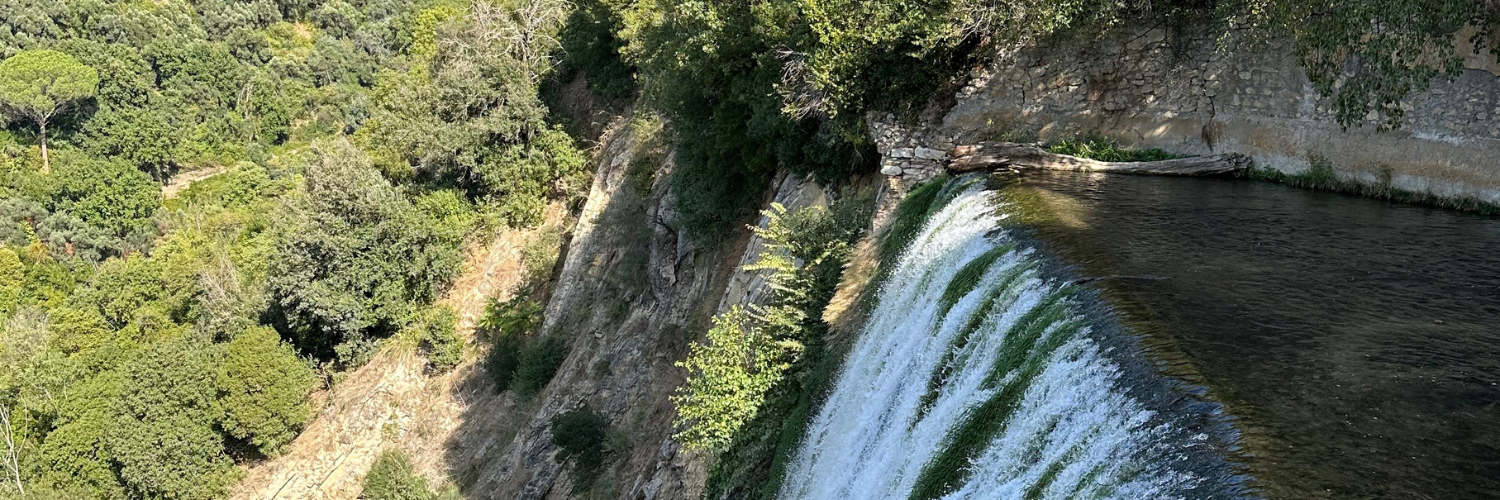
Nestled in the picturesque landscape of Italy, Tivoli is a hidden gem waiting to be explored. This charming town, just a short drive from Rome along the Via Tiburtina Valeria, offers a perfect blend of history, natural beauty, and therapeutic experiences. In this blog post, we’ll take you on a journey through the Aqua Trail, starting from the rejuvenating waters of Thermae of Albule, and exploring the historical significance of water in iconic landmarks like Hadrian’s Villa, Villa d’Este, Tivoli Gardens, and Parco Villa Gregoriana.
The Aniene River is a significant watercourse in central Italy, flowing through the region of Lazio. It is a tributary of the Tiber River, with its source located in the Apennine Mountains near Subiaco. The river travels approximately 98 kilometers (61 miles) before joining the Tiber in the northern suburbs of Rome. The Aniene River has historical and cultural importance, and it played a role in the ancient Roman world. The Romans built aqueducts to bring water from the Aniene into Rome, contributing to the city’s water supply. One of the notable aqueducts that drew water from the Aniene was the Aqua Claudia, part of the extensive Roman aqueduct system.
Follow the Waterways of Tivoli
Begin your Tivoli adventure at the Thermae of Albule in Tivoli Terme, a mere 20 km drive from Rome or a convenient 8 km drive from Tivoli. The thermal baths are a testament to the town’s rich history, offering visitors a chance to unwind in the healing waters that maintain a constant temperature of around 23°C throughout the year. The thermal baths owe their warmth to the remnants of an ancient volcano, providing a unique and soothing experience for those seeking relaxation and rejuvenation.
Anio Novus Aqueduct was started by Emperor Caligula in 38 AD. Many ruins of this aqueduct can be seen along the Via Empolitana in Tivoli. Località Arci, near Tivoli, has the remnants of the Aqua Marcia Aqueduct. Built in 144 BC, this colossal structure once drew water from the basin of the Aniene River. Remarkably, it stands as the only still functioning Roman aqueduct, a testament to the engineering prowess of ancient Rome. The aqueducts had a flow rate of about 180,000 cubic meters per day, along its 64-kilometer course. Marvel at the impressive ruins, allowing the whispers of history to transport you back in time.
Water at the Heart of Hadrian’s Villa
Hadrian’s Villa (circa 118–138 A.D.), a UNESCO World Heritage site, is a testament to the grandeur of ancient Roman architecture and landscape design. Water played a pivotal role in the functionality of this imperial residence. The villa features an intricate network of canals, pools, and fountains that showcase the Romans’ mastery of hydraulic engineering. The Canopus, a prominent feature of Hadrian’s Villa, was intricately designed to evoke the essence of the Nile River. While only a few tangible remnants, such as the crocodile on the banks of the replicated Nile, hint at the Egyptian inspiration.
The Maritime Theatre is a complex structure with 35 rooms constructed on a circular island encircled by a moat, where a unique rotating dining room once allowed guests to dine surrounded by water. Widely believed to have been dedicated to Hadrian’s personal use, this theatre showcases the emperor’s influence on the architectural layout. Adjacent to it, the bathing complex features numerous changing rooms and a sequence of hot, tepid, and cold baths. A noteworthy inclusion in the baths is a rare example of a heliocaminus, a sun-heated steam room. This domed chamber boasts expansive glass windows and an overhead lumen, facilitating the adjustment of steam levels and providing a space for sunbathing—a testament to the innovative and luxurious elements integrated into Hadrian’s architectural vision.
Villa d’Este a Symphony of Nature and Art
In the center of historic Tivoli, the enchanting Villa d’Este is a masterpiece of Renaissance architecture and waterscape. This UNESCO-listed site boasts stunning terraced gardens adorned with fountains, waterfalls, and ornate pools. The Villa’s famed Water Organ, powered by the force of falling water, adds a musical element to the serene surroundings. Tivoli Gardens, established in the 16th century, is a delightful blend of natural beauty.
Frans Liszt, the renowned Hungarian composer and pianist, found inspiration and artistic solace at Villa d’Este during his stay in the mid-19th century. The ethereal sounds produced by the water organ, blending seamlessly with the surrounding natural beauty, left an indelible mark on Liszt’s creative spirit and added a touch of aquatic magic to his musical legacy. Today, visitors to Villa d’Este can appreciate the same water organ that once stirred the imagination of the musical maestro, no playing a Liszt symphony. Immerse yourself in the harmony of nature and art as you stroll through the frescoed villa and the lush gardens guided by the soothing sounds of flowing water.
Parco Villa Gregoriana Nature’s Water Spectacle
Parco Villa Gregoriana is an awe-inspiring natural park that brings together lush landscapes and dramatic water features. It’s just a short stroll from Tivoli’s town center. Originally designed to redirect the Aniene River and prevent flooding, the park boasts deep gorges, waterfalls, and ancient ruins. Highlights include the Temples of Sybil and Vesta, along with the impressive Great Waterfall, all showcasing nature’s beauty in this picturesque sanctuary.
Tivoli, renowned for its water features and historical sites, offers a captivating mix of relaxation, history, and natural splendor. Whether you’re soaking in the therapeutic waters of the Thermae of Albule or marveling at the ancient aqueducts, Tivoli promises a unique and enriching travel experience. Discover the timeless allure of water at the heart of Hadrian’s Villa, Tivoli Gardens, and Parco Villa Gregoriana. Let this journey be a celebration of the enduring bond between humanity and the life-sustaining element of water


post a comment cancel reply
You must be logged in to post a comment.



